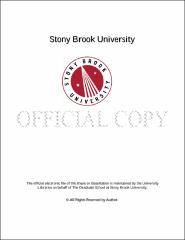| dc.identifier.uri | http://hdl.handle.net/11401/76970 | |
| dc.description.sponsorship | This work is sponsored by the Stony Brook University Graduate School in compliance with the requirements for completion of degree. | en_US |
| dc.format | Monograph | |
| dc.format.medium | Electronic Resource | en_US |
| dc.language.iso | en_US | |
| dc.publisher | The Graduate School, Stony Brook University: Stony Brook, NY. | |
| dc.type | Dissertation | |
| dcterms.abstract | One of the major goals of tissue engineering is to develop methods that reliably fabricate tissues and organs ex vivo for use/implantation in vivo. However, the ability to create large-scale 3D tissues at physiological cell densities is hindered by our inability to sustain cells. The main reason for this is that without an incorporated vascular network, the transport of nutrients and wastes are restricted to molecular diffusion, which is limited to approximately 100 µm in biological tissues. Here we have developed a casting based templating technology to create highly ordered microchannels in polymers for MRI phantom and in vitro tissue engineering applications. Existing cell culture and tissue engineering models use two-dimensional substrates to make a three dimensional construct. These types of devices fail to reproduce the microenvironment of the tissue resulting in cells that are not phenotypically similar or adept at culturing in 3D. The three-dimensional tissue cultures that do exist have been limited in size due to the need for a vascular network. Our new technology has the capability to have highly dense microchannels and can be scaled to any size to sustain a tissue construct. This new method for vascularizing hydrogels on chips and in bulk has the fidelity of a bottom-up system with the scalability of a top-down system. By bridging this gap in scale we can create larger tissue constructs to address fundamental and quantitative questions about human tissues. | |
| dcterms.abstract | One of the major goals of tissue engineering is to develop methods that reliably fabricate tissues and organs ex vivo for use/implantation in vivo. However, the ability to create large-scale 3D tissues at physiological cell densities is hindered by our inability to sustain cells. The main reason for this is that without an incorporated vascular network, the transport of nutrients and wastes are restricted to molecular diffusion, which is limited to approximately 100 µm in biological tissues. Here we have developed a casting based templating technology to create highly ordered microchannels in polymers for MRI phantom and in vitro tissue engineering applications. Existing cell culture and tissue engineering models use two-dimensional substrates to make a three dimensional construct. These types of devices fail to reproduce the microenvironment of the tissue resulting in cells that are not phenotypically similar or adept at culturing in 3D. The three-dimensional tissue cultures that do exist have been limited in size due to the need for a vascular network. Our new technology has the capability to have highly dense microchannels and can be scaled to any size to sustain a tissue construct. This new method for vascularizing hydrogels on chips and in bulk has the fidelity of a bottom-up system with the scalability of a top-down system. By bridging this gap in scale we can create larger tissue constructs to address fundamental and quantitative questions about human tissues. | |
| dcterms.available | 2017-09-20T16:51:34Z | |
| dcterms.contributor | Rubenstein, David A | en_US |
| dcterms.contributor | Strey, Helmut H | en_US |
| dcterms.contributor | Entcheva, Emilia | en_US |
| dcterms.contributor | Meng, Yizhi. | en_US |
| dcterms.creator | Kruse, Travis | |
| dcterms.dateAccepted | 2017-09-20T16:51:34Z | |
| dcterms.dateSubmitted | 2017-09-20T16:51:34Z | |
| dcterms.description | Department of Biomedical Engineering | en_US |
| dcterms.extent | 144 pg. | en_US |
| dcterms.format | Application/PDF | en_US |
| dcterms.format | Monograph | |
| dcterms.identifier | http://hdl.handle.net/11401/76970 | |
| dcterms.issued | 2016-12-01 | |
| dcterms.language | en_US | |
| dcterms.provenance | Made available in DSpace on 2017-09-20T16:51:34Z (GMT). No. of bitstreams: 1
Kruse_grad.sunysb_0771E_13153.pdf: 5019026 bytes, checksum: 85aeb48916f4dfd858d5b8f84500ac0c (MD5)
Previous issue date: 1 | en |
| dcterms.publisher | The Graduate School, Stony Brook University: Stony Brook, NY. | |
| dcterms.subject | Biomedical engineering -- Biology -- Medicine | |
| dcterms.title | Tissue Engineering Using 3D Template Casting | |
| dcterms.type | Dissertation | |

